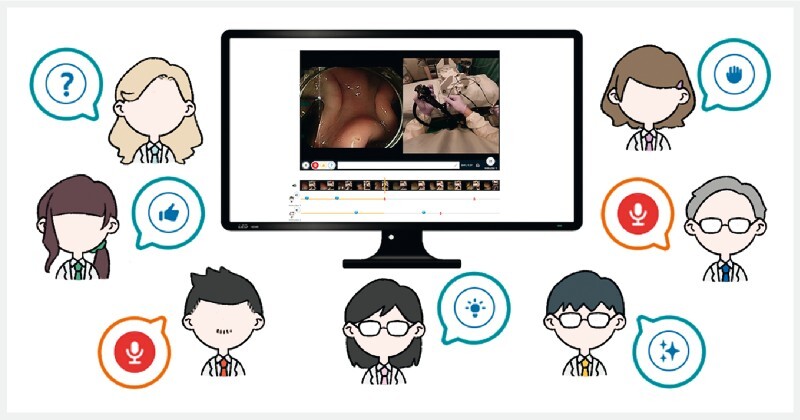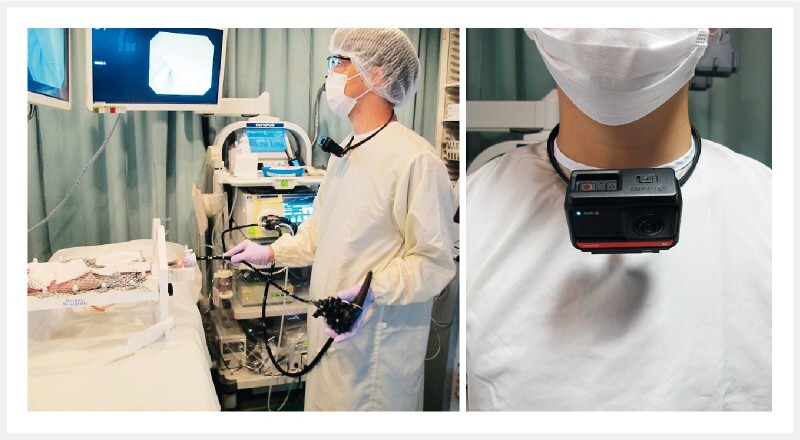Although instruction by experienced endoscopists is preferable for improving trainees’ endoscopic skills 1 2 3 4 , this is not always achievable in clinical practice because of manpower shortages or other circumstances. Recently, synchronous training (e. g. hands-on seminars) has become popular among endoscopy trainees. However, the opportunities to attend these events are limited and effective instruction is difficult to achieve in a short time. Tsucom (BonBon Inc., Kyoto, Japan) is an online platform supporting video-based asynchronous communication 5 . This platform allows intra-group communication at any time and place via addition of reactions by text and audio to uploaded videos ( Fig. 1 ). Herein, we demonstrate our novel training system using Tsucom for an endoscopic procedure in a porcine model ( Video 1 ).
Fig. 1.

Tsucom (BonBon Inc., Kyoto, Japan) is an online platform that supports video-based asynchronous communication within a group 5 .
Video 1 Demonstration of our novel endoscopy training system using Tsucom (BonBon Inc., Kyoto, Japan) for endoscopic submucosal dissection in the porcine stomach.
This demonstration was designed for a situation where a trainee could not receive direct instruction from instructors. The trainee performed endoscopic submucosal dissection on the porcine stomach and recorded the intraoperative endoscopic field. The endoscopic maneuver was also recorded with a 360° camera (Insta360; Arashi Vision Inc., Shenzhen, China) worn around the neck ( Fig. 2 ). The two video files were merged into one ( Fig. 3 ) and then uploaded to the platform. Two instructors respectively reviewed the video on the platform, and then used text and audio to point out how to improve the procedure. The 360° camera allowed free movement of the viewpoint and focus on any part of the endoscopic maneuver. The posted comments were overlaid directly onto the video and synced to specific playback times. While rewatching the commented video, the trainee could simulate an experience of real-time instruction and obtain sufficient feedback ( Fig. 4 ).
Fig. 2.

A trainee’s endoscopic maneuver was recorded with a 360° camera (Insta360; Arashi Vision Inc., Shenzhen, China) worn around the neck.
Fig. 3.

The two video files (one of the endoscopic field and the other of the endoscopic maneuver) were merged into one.
Fig. 4.

The trainee could share the URL of the uploaded video with the instructors for feedback.
This endoscopy training system may provide a preferable learning environment for endoscopists who are unable to receive sufficient hands-on training or post-training feedback, not only within a specific facility, but across countries and regions.
Endoscopy_UCTN_Code_TTT_1AU_2AB
Acknowledgments
We thank Motoi Suzuki (BonBon Inc.) for filming cooperation and Edanz ( https://jp.edanz.com/ac ) for editing a draft of this manuscript.
Footnotes
Competing interests M. Soshi is the chief executive officer and a shareholder of BonBon Inc. T. Inoue, T. Utsumi, N. Agatsuma, Y. Nishikawa, Y. Sano, and H. Seno declare that they have no conflict of interest.
Endoscopy E-Videos : https://eref.thieme.de/e-videos .
Endoscopy E-Videos is an open access online section, reporting on interesting cases and new techniques in gastroenterological endoscopy. All papers include a high quality video and all contributions are freely accessible online. Processing charges apply (currently EUR 375), discounts and wavers acc. to HINARI are available. This section has its own submission website at https://mc.manuscriptcentral.com/e-videos
References
- 1.Waschke K A, Anderson J, Valori R M et al. ASGE principles of endoscopic training. Gastrointest Endosc. 2019;90:27–34. doi: 10.1016/j.gie.2018.10.017. [DOI] [PubMed] [Google Scholar]
- 2.Pimentel-Nunes P, Pioche M, Albéniz E et al. Curriculum for endoscopic submucosal dissection training in Europe: European Society of Gastrointestinal Endoscopy (ESGE) Position Statement. Endoscopy. 2019;51:980–992. doi: 10.1055/a-0996-0912. [DOI] [PubMed] [Google Scholar]
- 3.Kakushima N, Hirasawa K, Morita Y et al. Terminology for training of endoscopic submucosal dissection. Dig Endosc. 2012;24:133–135. doi: 10.1111/j.1443-1661.2012.01257.x. [DOI] [PubMed] [Google Scholar]
- 4.Goda K, Fujishiro M, Hirasawa K et al. How to teach and learn endoscopic submucosal dissection for upper gastrointestinal neoplasm in Japan. Dig Endosc. 2012;24:136–142. doi: 10.1111/j.1443-1661.2012.01274.x. [DOI] [PubMed] [Google Scholar]
- 5.BonBon Inc Tsucom. A communication tool where you can comment on videos using voice and textAvailable at (accessed 04.09.2022):https://bon-bon.co.jp/tsucom-eng


